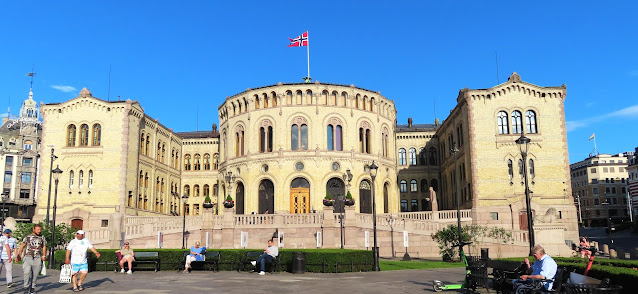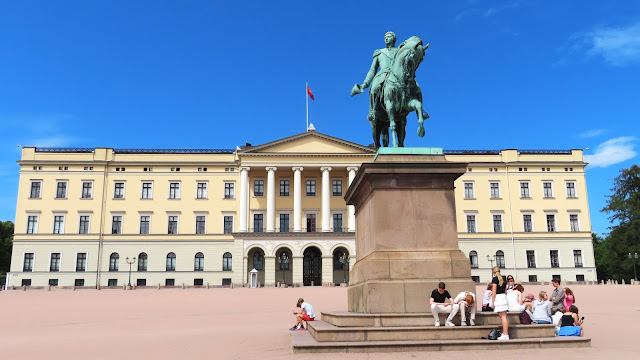I think I may have beat my record for steps in a day today – 23, 227 and just under 10 miles of walking all over this busy city. Our tour group met our guide, Lars, right after breakfast, and took a walking tour of the old heart of Oslo. Much of it was familiar to me, but I actually did learn things about Oslo’s history that I had either forgotten or never learned, such as the location of the first and oldest buildings of Oslo, located in Kristiania Torv, which is where we started our tour. Kristiania was the original name of this city, and this square contains the original Rådhus (City Hall) and an interesting sculpure of a hand, which symbolized King Christian IV's resolve to rebuild the city after it burned down in 1624.
 |
| Our Oslo tour guide, Lars. |
 |
| Kristiania Torv (Christiania Square) |
 |
| Our group listens to Lars tell the history of the city. |
After leaving the square, we walked through "Gamle Byen," the old city where we saw Kristiania's Eldest Hus, the oldest house still standing here, and some of the walls of the old city.
 |
| Gamle Byen - the Old City |
Oslo has certainly grown a lot since I lived here! We visited a very new section of town, including the gleaming white Opera House with it's accompanying iceberg in the harbor, and the huge Olso Library - both extremely modern and architecturally fascinating.
 |
| The Oslo Opera House. Visitors can walk to the roof. |
 |
| The modern Oslo Library |
Wen ended our tour with a walk down Karl Johans Gate, the main street of Oslo, which starts at the harbor and ends at the Royal Palace. The street is lined with lovely old buildings filled with modern stores and hotels, and a long park filled with flowers, trees, and fountains - a lovely green oasis in the heart of the city.
 |
Interesting sights around Oslo. The Oslo Tiger, an astonomical clock on the Helly Hansen building, Karl Johans Gate, and some royal coats-of-arms.
Why a Tiger? Here is information from "Visit Oslo":
The tiger in front of Oslo Central Station is one of Oslo's most photographed "inhabitants" and one of the first things that meet a visitor arriving at Oslo Central Station.
When Oslo celebrated its 1000-year anniversary in 2000, Eiendomsspar wanted to give the city a gift. Oslo wanted a tiger, and that's what they got: a 4.5-metre bronze tiger made by Elena Engelsen.
Why a tiger?
The reason Oslo wanted a tiger, is the city's nickname Tigerstaden ("The Tiger City"), which most Norwegians are familiar with. The name was probably first used by Norwegian poet Bjørnstjerne Bjørnson. His poem "Sidste Sang" from 1870 describes a fight between a horse and a tiger; the tiger representing the dangerous city and the horse the safe countryside.
Since then Oslo has been known as "The Tiger City", but these days it's not necessarily meant as a negative thing. "The Tiger City" can be an exciting and happening place rather than dangerous.
|
 |
| Downtown Oslo |
Along the way, we saw the Old Aker Church, the oldest existing building in Oslo, with some of its walls constructed in the 12th century. We also paid our respects to Henrik Gibson, the author of "Peer Gynt" and "The Doll House" outside of the National Theater.
The rest of the day was free to do whatever we liked. I spent the rest of the day exploring as much of the city as possible. I ran into Bruce and together, we explored the Rådhus, the red brick City Hall at the top of the harbor. The inside is fabulous, with mosaics celebrating the history of the people, on the outside walls are wonderful wood carvings depicting the Norse gods. Each one of these came with a description of the myth associated with the carving.
 |
| The Rådhus, Oslo's City Hall. The statue on the wall is Harald III, King of Norway from 1046 to 1066. |
 |
| The lobby of the Rådhus. |
 |
| Murals inside the Rådhus |
 |
| Wooden carvings of Norse Mythology at the entrance to the Rådhus. |
 |
| The two figures in the top row are the Norse versions of Adam and Eve - They are Ask (ash) and Embla (elm). The three gods, Odin, Hone, and Lodur, gave life to two trees, bringing forth the first humans. |
After the tour of the Rådhus, I went on alone to the Royal Palace, still the home of the Norwegian royal family. The tours of the palace don’t start until later in the month, so I spent some time in the beautiful (and cool) park behind the palace. Our guide had mentioned a famous statue of a spider that I had never seen, so I asked a local where to find it. (I was able to ask in Norwegian! I always wondered why Duolingo was teaching me how to say spider in Norsk, but I'm glad it did.) Wow, it was quite an impressive sculpture! Huge spindly legs holding up the spiders body – with an egg sack – towering over my head. Let’s hope she doesn’t hatch those eggs! The spiders would quickly dominate the city!
Back at the harbor, I passed by the Nobel Peace Prize Museum, which I had visited before. Then I was just in time for the ferry to Bygdøy, an island filled with interesting museums, a folk village, and Oskarshall, the royal summer palace where I had had lunch with King Olav many years ago. The ferry ride was beautiful in the warm, sunny summer weather, with lots of sights along the way.
 |
| Most of the Nobel Prizes are awarded in Stockholm, but the Peace Prize is given here. |
 |
Sights from the ferry: the Rådhus, Akershus Fortress, Holmenkollen Ski Jump on the hill, and the triangular buildings that house the Fram, Kon-Tiki, and Long Ship Museums of Bygdøy.
Holmenkollen Ski Jump dates back to 1892, although it has been re-built several times.
|
 |
| Oskarshall, the summer palace of the Norwegian royal family. |
Unfortunately the Long Ships Museum was closed for reconstruction, but I spent a couple of hours in the Fram and Kon Tiki museums. Both of the ship museums were fascinating. The Fram was used by Norwegian explorers Fridtjof Nansen and Roald Amundsen. Nansen wanted to go further into the Arctic than ever before by building a ship that would withstand the pressures of the arctic ice. In an attempt to reach the North Pole, he and the crew were purposefully marooned in the ice for three years, surviving on polar bears and seal and walrus blubber, in their attempt to prove that the currents would move their ship west. Amundsen used the Fram to become the first man to reach the South Pole. As with the Vasa ship in Stockholm, visitors are able to actually board the large schooner and explore the rooms where the crew had lived and worked.
 |
| The Fram ship |
The Kon-Tiki Museum was even more interesting. I took my time and read all of the information about Thor Heyerdahl’s life and vision. He had lived in the Marquesas Islands with his wife and wanted to show that it would have been possible for people from South America to have settled the south seas islands. Although it has been proven now that these islands were primarily settled by people from Asia, the Kon-Tiki raft, built of materials like balsa wood available to the South American people, did survive the voyage. And new DNA testing has shown that some things, such as sweet potatoes, came from South America, so it is likely that there was some interaction between the two sides of our globe in these islands.
 |
| Thor Heyerdahl and his wife on Fatu Hiva in the Marquesas Islands. |
 |
| Thor Heyerdahl aboard Kon Tiki |
 |
| The original Kon Tiki sits in the museum |
 |
| Some of the equipment used by the crew...and a shark. |
This was only one of Heyerdahl’s many adventures. He found similarities between the cultures of ancient Egypt and the New World, so he built the Ra and the Ra II out of papyrus reeds to show that travel could have been possible between the Mediterranean and South America. While the second raft did (barely) survive the journey, it is unlikely that Egyptian explorers traveled to the New World.
 |
| A replica of the Ra, made of papyrus reeds |
 |
| The Ra |
 |
| The Ra at sea |
Heyerdahl also led the one of the earliest archaeological expeditions to Easter Island where his team attempted to solve the mystery of the Moai, the giant heads, which had fascinated him since childhood.
 |
| Heyerdahl and his archaeological team raising a Moai |
The journey of the Ra became the most important of his voyages for an unexpected discovery. He and his crew noticed a large amount of pollution, including spilled oil from tankers in many places along the route. His advocacy in ocean conservation led to global efforts to address this problem. While the Kon-Tiki in the museum is the original, the Ra is a replica, as Heyerdahl burned the original in protest to the continuing pollution of our oceans. The story is best told through these posters from the museum.
The ferry ride back to the city was beautiful. The wharf was crowded with Norwegians enjoying the sunshine on the only "beach" available in the city.
 |
| Boat in the Oslo Fjord |
 |
| Akershus Fortress has protected the city since 1300! |
 |
| A Norwegian city "beach" |
 |
| Norwegians are out in the sun as much as possible in the summer. |
Back in Oslo, I had lunch in the very new National Museum, which had a wonderful art gallery featuring many Norwegian painters, including two rooms devoted to Edvard Munch, Norway's most celebrated artist, renowned for “The Scream.”
 |
| The Scream - one of several versions of this painting. |
 |
| Three self-portaits by Edvard Munch - 1886, 1895, and 1919 |
 |
| Various paintings by Munch. I see the resemblance to the Scream's face in some of the later faces. |
I especially enjoyed the paintings by other Norwegian painters, which often celebrated daily life and the gorgeous natural beauty of Norway.
 |
| Landscapes and people of Norway by various Norwegian artists |
There were also painting by other well-known artists...Degas, Gauguin, Van Gogh, Manet, and others. I only had time to wander through one floor of the three floor museum. I guess I will have to come back!
 |
Van Gogh (self-portrait), Gauguin, Manet, Degas, Cezanne,
and painted fan showing several artists. |
The day ended with Happy Hour with my tour group at the Lekter’n Bar right on the wharf. We have all become good friends, and there was lots of good conversation and lots of laughter. I have discovered my favorite drink – Somerby’s Pear Cider. Yum!
I was completely exhausted by the busy day and still had to pack up for the next day, so I headed back to the hotel early and collapsed. Oslo was much larger and much busier than it had been when I lived here so long ago, and I can’t say that I like all the changes. Although I did admire the beautiful and modern Opera and Library, a lot of the other newer architecture is not particularly noteworthy or beautiful to my eyes. But the heart of the old city is still charming, and I was very happy to be back in my favorite Scandinavian country. Tomorrow, we would head toward the beautiful mountains on our way to Bergen



































































































